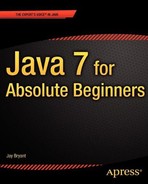Book Description
Java 7 Programming for Absolute Beginners introduces the new core, open source Java Development Kit. Its focus is on practical knowledge and its completeness—it provides all the bits and pieces an utter novice needs to get started programming in Java.
It seems as if everyone is writing applications or apps these days for Android, BlackBerry, and the enterprise—it's where the money's at. But, how do they do it? Well, it's best to start by learning Java, one of the most popular programming languages around these days, still. Yes, that's right.
This book:
Teaches Java development in language anyone can understand, giving you the best possible start
Provides simple, step-by-step examples that make learning easy, allowing you to pick up the concepts without fuss
Offers clear code descriptions and layout so that you can get your code running as soon as possible
What you'll learn
How a computer processes programs
Write a program in Java
Debug a program
Choose and manipulate the data structures that best match your purpose
Create a user interface in Java
How to do animation in a Java program
Advanced topics such as thread management and recursion that any programmer will soon need
Who this book is for
Everyone! This book is for anyone who wants to learn to develop applications or apps for the enterprise or mobile using Android or BlackBerry and much more. No previous programming experience is necessary.
Table of Contents
- Title
- Dedication
- Contents at a Glance
- Contents
- Foreword
- About the Author
- About the Technical Reviewer
- Acknowledgments
- Introduction
- Chapter 1: Writing Your First Java Program
- Chapter 2: Java Syntax
- Chapter 3: Data Types
- Chapter 4: Operators
- Chapter 5: Control Flow, Looping, and Branching
- Chapter 6: Object-oriented Programming
- Chapter 7: Writing a User Interface
- Chapter 8: Writing and Reading Files
- Chapter 9: Writing and Reading XML
- Chapter 10: Animation
- Chapter 11: Debugging with Eclipse
- Chapter 12: Video Games
- Chapter 13: Garbage Collection
- Chapter 14: Recursion
- Chapter 15: Generics and Regular Expressions
- Index
